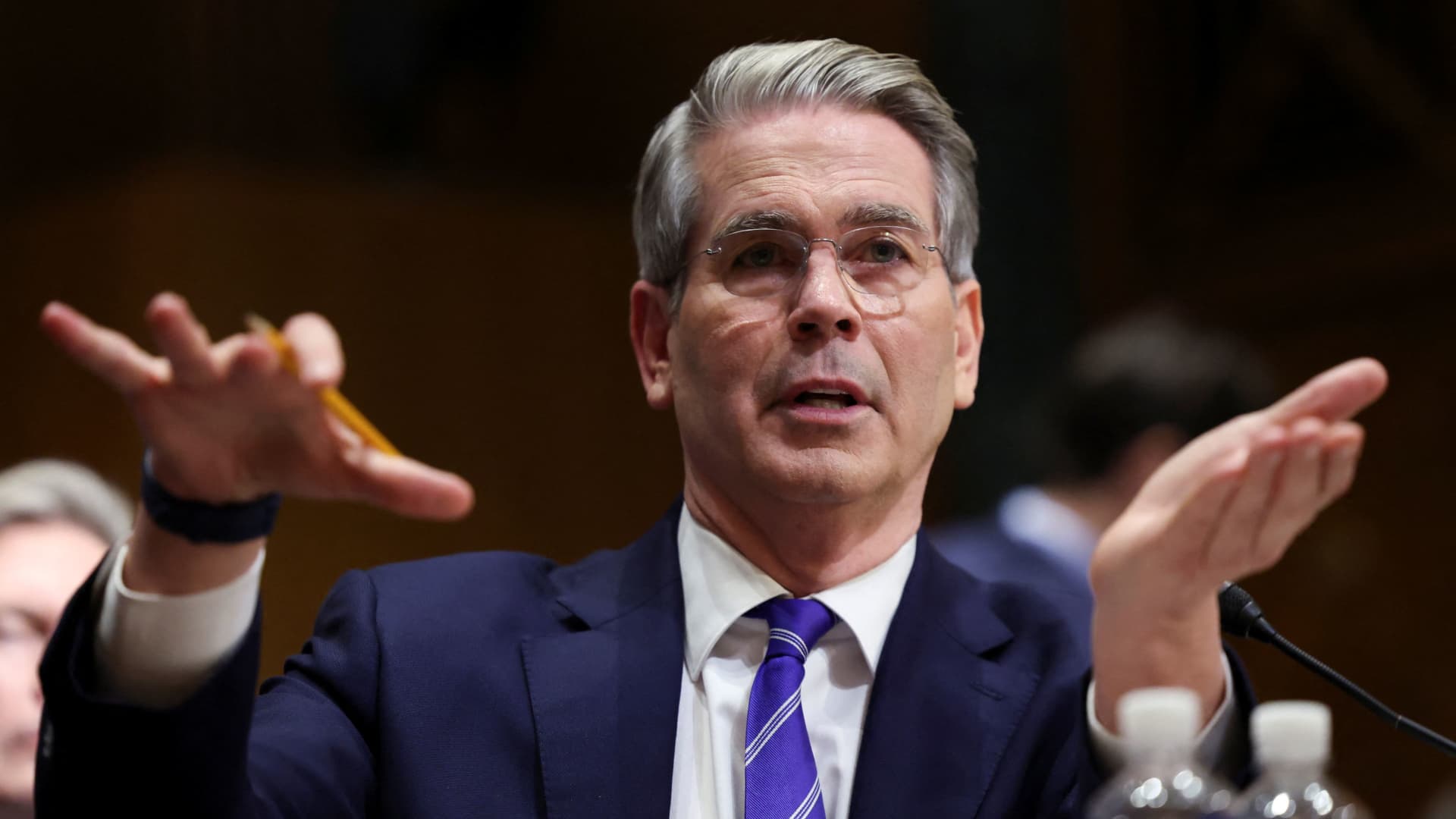
US Holds the Upper Hand in Trade War with China, Says Treasury Secretary
Amidst escalating tensions and reciprocal tariff threats between the United States and China, Treasury Secretary Scott Bessent has asserted that the U.S. possesses a significant advantage in this burgeoning trade war. Bessent’s comments, made during an interview on CNBC’s “Squawk Box,” suggest a calculated confidence in the U.S. position, painting China’s recent escalations as a misstep. His analysis hinges on the fundamental imbalance in trade volumes between the two nations, with the U.S. exporting considerably less to China than it imports. This disparity, according to Bessent, puts China in a strategically weaker position, akin to “playing with a pair of twos.”
Bessent’s remarks come at a crucial juncture, just ahead of the U.S. implementing increased duties on Chinese goods, alongside tariffs on numerous other nations. These so-called reciprocal tariffs are designed to serve as a catalyst, compelling trading partners to engage in negotiations and, crucially, to bring jobs back to American soil. The strategy is not merely about imposing financial penalties but about incentivizing collaborative discussions that address trade imbalances and promote domestic economic growth. Bessent highlighted Japan as a proactive example, already demonstrating eagerness to negotiate, and expressed optimism that many other countries with substantial trade deficits would soon follow suit.
The underlying objective, as articulated by Bessent, is to stimulate both job creation and revenue generation through the implementation of tariffs. The vision is one where tariff walls serve as a temporary measure, encouraging the repatriation of manufacturing facilities to the U.S. In the interim, the tariffs would generate substantial revenue, providing a financial cushion and potentially offsetting any negative economic impacts. Bessent envisions a scenario where tariffs gradually diminish as manufacturing returns to the U.S., with the resulting payroll taxes from the new industries contributing to a balanced economic landscape.
The Strategy Behind Reciprocal Tariffs
The implementation of reciprocal tariffs is a strategic maneuver designed to address trade imbalances and encourage fairer trade practices. The core idea behind these tariffs is to incentivize countries with significant trade deficits with the U.S. to come to the negotiating table and address the root causes of these imbalances. By imposing tariffs on imported goods, the U.S. aims to make foreign products more expensive, thereby reducing demand and encouraging consumers to purchase domestically produced goods. This, in turn, is expected to stimulate domestic production and create jobs in the U.S.
However, the strategy is not without its potential drawbacks. Tariffs can lead to higher prices for consumers, as businesses may pass on the cost of the tariffs to their customers. They can also provoke retaliatory measures from other countries, leading to a trade war where everyone loses. Therefore, it is crucial to implement tariffs judiciously and to use them as a tool to encourage negotiation and compromise, rather than as a weapon to punish trading partners.
Bessent emphasized that the U.S. is not solely focused on absolute tariff levels but also on addressing non-tariff barriers to trade. These barriers, such as currency manipulation and value-added taxes, can be more difficult to quantify and address than traditional tariffs. By tackling these non-tariff barriers, the U.S. aims to create a level playing field for American businesses and ensure that they can compete fairly in the global market.
China’s Response and the Potential for Escalation
Despite the U.S.’s optimistic outlook, China has adopted a defiant stance, vowing to “fight to the end” in this trade dispute. China has already imposed tariffs on U.S. products in retaliation for the U.S.’s actions, and President Trump has threatened to escalate the situation further by imposing additional tariffs on Chinese imports if the initial tariffs are not withdrawn. This tit-for-tat escalation raises concerns about a potential trade war that could have significant consequences for the global economy.
The U.S. ran a nearly $300 billion trade deficit with China in 2024, representing about one-third of the entire U.S. trade imbalance. Trump’s administration hopes that tariffs will open up more markets for American products and encourage manufacturers to relocate their operations back to the U.S. However, the success of this strategy hinges on China’s willingness to negotiate and compromise. If China remains steadfast in its opposition to U.S. tariffs, the trade dispute could escalate further, leading to a prolonged period of economic uncertainty.
Bessent acknowledged that some 70 countries have expressed interest in initiating trade talks with the U.S., but China has taken a firm stance against negotiation. In response, President Trump has threatened to impose a 50% tariff on Chinese imports if the initial tariffs are not rescinded. This aggressive posture underscores the high stakes involved and the potential for a protracted and damaging trade conflict.
Beyond Tariffs: Addressing Non-Tariff Barriers
While tariffs have taken center stage in the trade dispute, the Trump administration is also focusing on addressing non-tariff barriers to trade. These barriers, which include currency manipulation, Europe’s value-added tax, and other hidden practices, can be more difficult to quantify and address than traditional tariffs. According to Bessent, academic research indicates that non-tariff barriers are often more insidious because they are hidden and obfuscated, making them harder to detect and counteract.
Currency manipulation, for example, occurs when a country deliberately undervalues its currency to make its exports cheaper and its imports more expensive. This gives the country an unfair advantage in international trade and can harm businesses in other countries. Similarly, value-added taxes, which are common in Europe, can create a disadvantage for American businesses that export to those countries. By addressing these non-tariff barriers, the U.S. aims to create a more level playing field for American businesses and ensure that they can compete fairly in the global market.
Bessent emphasized that “everything is on the table” when it comes to trade negotiations. This suggests that the U.S. is willing to consider a wide range of options to address trade imbalances and promote fairer trade practices. Whether this approach will lead to a resolution of the trade dispute with China remains to be seen, but it is clear that the U.S. is prepared to take a firm stance to protect its economic interests.
Conclusion: Navigating the Complexities of Trade
The trade war between the United States and China is a complex and multifaceted issue with significant implications for the global economy. While Treasury Secretary Scott Bessent expresses confidence in the U.S.’s strategic advantage, the situation remains fluid and fraught with uncertainty. The success of the U.S.’s approach hinges on its ability to persuade China and other countries to come to the negotiating table and address trade imbalances and non-tariff barriers to trade. However, the potential for escalation and the risk of a prolonged trade war cannot be ignored.
Ultimately, a resolution to the trade dispute will require compromise and a willingness to address the underlying issues that have led to trade imbalances. Whether the U.S. and China can find a path towards a mutually beneficial agreement remains to be seen. However, the stakes are high, and the outcome of this trade war will have a lasting impact on the global economic landscape.




